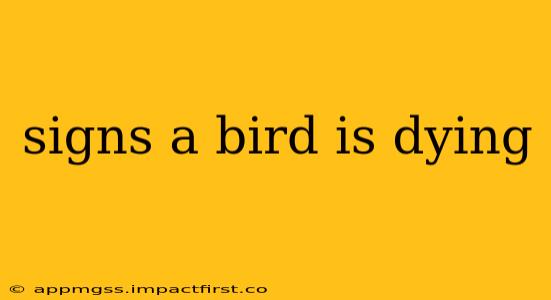Losing a bird, whether a beloved pet or a wild creature you've encountered, is heartbreaking. Understanding the signs a bird is dying allows for compassionate care, whether you're trying to help a wild bird or providing comfort to your feathered friend. This guide will explore the key indicators of a dying bird, offering insights to help you during this difficult time.
What are the signs of a dying bird?
Recognizing the subtle and overt signs a bird is nearing the end of its life is crucial. These signs can vary depending on the species, age, and underlying health conditions. However, some common indicators are consistently observed.
Behavioral Changes:
- Lethargy and Weakness: A significant decrease in activity level, difficulty perching or standing, and overall weakness are strong indicators. The bird may appear listless and unresponsive to its surroundings.
- Loss of Appetite and Dehydration: A refusal to eat or drink is a critical warning sign. Check for sunken eyes, dry mouth, and a lack of droppings as these indicate severe dehydration.
- Difficulty Breathing: Noticeable labored breathing, gasping, or open-mouthed breathing are signs of respiratory distress and can indicate a serious underlying condition. Listen for unusual wheezing or clicking sounds.
- Isolation and Hiding: Birds that are usually social may withdraw and isolate themselves, seeking shelter away from others. This is often a sign of extreme weakness or pain.
- Abnormal Posture: A bird may hold its wings drooped, its head tucked down, or exhibit an unnatural posture. This signifies discomfort and potential internal problems.
- Lack of Response to Stimuli: A lack of reaction to sounds, movements, or attempts to interact is a serious indication that the bird may be nearing death.
Physical Signs:
- Loss of Feathers: Feather loss, particularly around the breast, can be a sign of malnutrition, disease, or stress. Excessive feather plucking can also indicate discomfort.
- Pale or Discolored Legs and Feet: Pale or bluish legs and feet can signify poor circulation, shock, or internal bleeding.
- Discharge from Eyes, Nose, or Mouth: Any discharge from the eyes, nose, or mouth can indicate infection or illness.
- Diarrhea or Changes in Droppings: Unusual changes in the color, consistency, or frequency of droppings can indicate digestive issues.
- Weight Loss: Significant weight loss, easily noticeable in pet birds, is a clear sign of declining health.
How can I tell if a wild bird is dying?
Identifying the signs in wild birds can be challenging as they often conceal illness to avoid predation. Focus on observing behavioral changes like extreme lethargy, inability to fly, or prolonged sitting in an exposed position without attempting to seek shelter. If you find a wild bird exhibiting these symptoms, contact a local wildlife rehabilitator for guidance. They are best equipped to assess the bird's condition and provide appropriate care.
What should I do if my pet bird is dying?
If your pet bird is displaying any of the signs mentioned above, seek immediate veterinary care. A veterinarian can diagnose the underlying cause and offer palliative care to ease the bird's discomfort. They can help you make difficult decisions regarding end-of-life care, providing guidance and support during this challenging time.
What are the causes of death in birds?
The causes of death in birds are varied and can include diseases, injuries, malnutrition, stress, and old age. Determining the exact cause is often complex and requires professional assessment.
How do I know if my bird is in pain?
Signs of pain in birds can be subtle and may manifest as changes in behavior, posture, vocalizations, or appetite. If you suspect your bird is in pain, contact an avian veterinarian immediately. Early intervention can often improve the bird's comfort and potentially prolong its life.
Remember, observing these signs doesn't necessarily confirm the bird's imminent death, but it does signal the need for close monitoring and potentially professional intervention. Providing comfort and support during this difficult time, whether for a pet or a wild bird, demonstrates compassion and respect for these incredible creatures.
